Yesterday, the US Army’s Program Executive Officer Soldier, responsible for the development, procurement, and lifecycle management of weapons and equipment used by the individual Soldier, hosted a media round table to update us on the Jungle Combat Boot (ver 2) and Improved Hot Weather Combat Uniform. These two pieces of vital clothing are intended for use in a hot, wet environment.
Providing the update was COL Stephen Thomas, Product Manager, Soldier Protection and Individual Equipment; LTC Jonathan Allen, Product Manager Soldier Clothing and Individual Equipment; and CPT Dan Ferenczy SCIE Assistant Product Manager, Environmental Clothing and Footwear. Both COL Thomas and LTC Allen came on board over the Summer while CPT Ferenczy has been working on this project for about a year.
COL Thomas kicked off the event with a brief overview of PM SPIE. He was followed by LTC Allen who brings a lot of energy to PM SCIE, which he refers to as the “Varsity Team” of PEO Soldier. He wanted to thank everyone who got them to where they are today in this project, Army and industry alike.
Jungle Combat Boot
Current issue boots are less than optimal for wear in the jungle. They lack puncture protection and feature additional layers for comfort which retain moisture. Initially, the Army evaluated Commercially available boots but found that they didn’t dry quickly and lacked drainage and traction in mud and didn’t shed excess mud.
Intended for use in a tropical, or hot wet environment, the Jungle Combat Boot has been a fast tracked acquisition. Within six months of the directed requirement being issued, the Army had taken delivery of the initial generation of boots and was fielding them to two Brigade Combat Teams in the 25th Infantry Division.
Fielding of an initial capability was so fast because readiness is the Army’s number one priority. However, the PM SCIE team has relied heavily on Soldier feedback to refine the requirement. For example, Soldiers want a boot that is more flexible, lighter weight and has a less thick sole than those initially fielded. The version 2 JCBs will also dry an hour faster than currently issued boots and feature a puncture resistant sole incorporating material which resists 200 lbs sq in of force. This will not only protect from thorns but also man made threats such as the “punji stakes” used in Vietnam.
PM SCIE is currently working with industry to conduct a wear test of a Gen 2 boot incorporating changes in 2nd Quarter FY18. In alphabetical order, the vendors are Altama, Bates, Belleville, McRae and Rocky. Based on feedback next March, PM SCIE will combine the best attributes into a common requirement. However, boots will continue to be refined until Soldiers are satisfied.
When asked if the Army had been working with SOCOM and the Marine Corps, both of whom also have Jungle Boot requirements, LTC Allen answered that they had. He related that the Army, Marine Corps and SOCOM teams work regularly together, sharing information. But, while the overall objective is a common boot for all services there are different requirements. For example, Marines prefer a 6-8″ tall boot, whereas Soldiers desire a taller boot.
Improved Hot Weather Combat Uniform
The IHWCU is intended as an alternative for the Army Combat Uniform for wesr in jungle environments. While the two uniforms share the Army’s Operational Camouflage Pattern, the design and fabric are both different.
The overall layout of the uniform is the most obvious difference. CPT Ferenczy said that they had also incorporated a quick dry fabric and long with general performance improvements. Overall, there are fewer layers and seams.
Jacket Improvements
No mandarin collar
Old style shoulder pockets with buttons
No breast pockets
Trouser Improvements
No rear pockets
Gussetted crotch
Articulated knee
Mesh ankle wrap
Aside from the fabric improvement, there are five major features on this uniform I’d like to point out. First, the lack of both chest and rear pockets. Second, the return to a more traditional, vertically oriented, button flapped shoulder pocket. Third, the reverse rake on the trouser cargo pockets, with the front of the pocket and flap being higher than the rear. Fourth, the introduction of a gusseted or diamond crutch for increased mobility and to reduce blowouts. Finally, the incorporation of the mesh ankle wrap. This feature has been quite popular and works like a gaiter to protect the Soldier’s legs from bugs and other pests when the trousers aren’t bloused due to heat and drainage concerns.
While the goal has been to reduce the amount of fabric on the garment, I’m surprised they’ve retained the lower leg pockets which don’t seem to offer much capability considering they will constantly catch on vegetation and fill with water. I’m also curious if any of these features will find their way over to the ACU.
Fabric
The current fabric being used for the IHWCU is a 5.7 oz, 57/43 NYCO blend by Invista. According to CPT Ferenczi, this new fabric also offers improved air permeability (breathability) of 70cfm versus the 30cfm of the ACU’s 50/50 NYCO. Thanks to the new fabric and design, the IHWCU boasts a 30 min faster dry time over the current 90 minutes for the ACU.
However, the Army is preparing to conduct a lab test of new hot weather fabrics and based on what they find, they plan to conduct an additional wear test of promising fabrics later this year.
When You’ll See Them
According to LTC Allen, 65,000 sets of the IHWCU are currently in production. In January, they plan to issue four uniforms and one pair of boots each to soldiers in one Hawaii-based battalion of the 25th ID.
Unless you’re in one of the test units at the 25th ID, there’s no word yet in when you’ll be issued the IHWCU and JCBs. The Army is still at least a year out from a final decision and hasn’t decided if these will become Clothing Bag items, common to all Soldiers or issued at CIF as Organizational Clothing and Individual Equipment.
PEO Soldier photos by Ronald T Lee.


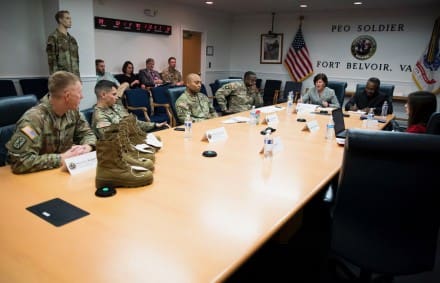
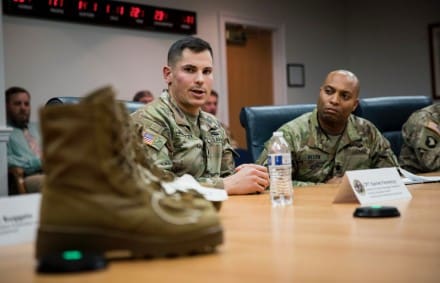
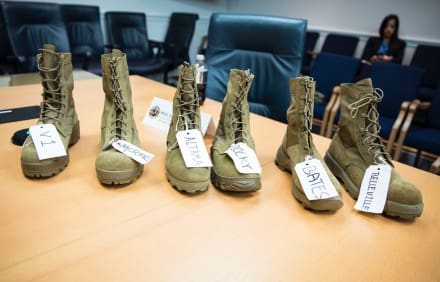
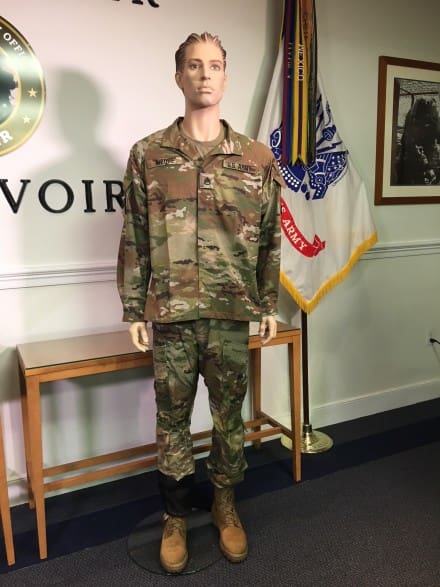
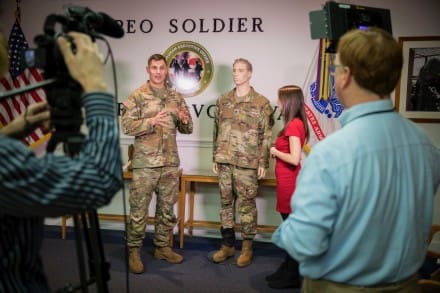
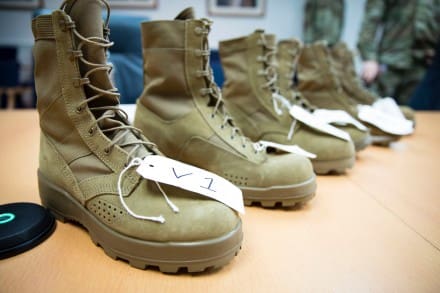
The V1 boots are garbage. I’ve never worn such a clunky boot, the sole on them is ridiculously thick.
I personally like my V1 Jungle boots. I’ve been wearing mine for years. Not sure if you have actually worn the genuine GI Jungle boots because I can say from experience that reproductions suck compared to the real thing.
The V1s we are talking about are detailed here.
https://soldiersystems.net/2017/03/06/us-army-unveils-new-jungle-combat-boot/
Oh and I don’t know anyone that wants an 8″ boot. We’re required to wear one, there’s a difference.
My first thought exactly! “Soldiers” typicically have either no opinion or an uninformed opinion based on little breadth of experience. It is likely that SGMs are those who prefer 8”+ boots.
In the case of Jungle Boots, the extra height might be warranted, but not in the boots Soldiers wear on a daily basis. A 6” boot would be lighter and put less pressure on the Achilles.
I spent a fair amount of time in the jungle, wearing BDUs. My unit continued to wear BDUs in the jungle for quite a while after the BDU wear-out date.
Some recommendations from my POV would be:
1) Put the upper chest pockets back on. We used those quite a bit.
2) No zippers, all closures should be button.
3) No mandarin collar is good, ensure that one can still button it all the way up to the collar.
4) No elastic bands.
For boots, after the old j-boots went away, I started wearing Garmont T8s for everything but extreme cold weather. T8s worked really well in the jungle.
**Trigger Warning For LowSpeed, this may hurt your feelings!!!***
That is some cool hair on that mannequin.
JMG
Excellent points. I would add, if the design is really for hot weather and the shirt will be worn outside the pants, instead of tucked in, then add lower pockets on the blouse. The Vietnam style jungle fatigues (even those with epaulets) would be good starting point for design. Don’t reinvent the wheel.
There are definitely times when you’ll tuck your coat in. During VN, SF guys cut their bottom packets off for a reason. Btw, the Army doesn’t wear blouses. Those are for Girl Scouts and Marines.
What about the Patagonia Jungle Uniform? I realize that it was/is a SOCOM requirement but..why are we messing with another new uniform when there is one in the system..since….2013?
Removing pockets is a good thing?
I would say it’s weird… I can understand the heat build-up but pockets are more than useful.
But how useful with armor on the torso? There’s no going back in terms of that. I mean, i’m more upset about the standard uniform design. Pockets are angled inward still on the new ACU, if they faced the other way they could access them a lot more easily. Paraclete did it that way on their SOF BDU, but nobody else seems to have caught onto that. It makes a lot of sense removing them on the Jungle HWACU. If you wanna talk about heat build up, think about the Ballistic inserts they designed for the chest pockets on the OG-107 for troops in Vietnam, that didn’t work out at all Lol.
That whole armored like a turtle deal will be rapidly re-evaluated once guys are kneeling over from heat prostration an hour into a patrol.
Hopefully a minimalist system with the next gen armor works out for that. And is ventilated. Probably a lot of IOTVs would have their cords ripped in the rice paddies to keep joes from drowning.
Armor needs to not be a thing. I know our risk averse organizations don’t believe that for big Army, but it only causes problems.
Sorry man, but bullets and shrapnel are gonna need to not be a thing for that.
You probably want FR was well.
May as well, gonna have heat exhaustion issues anyways why not exasperate it and bring it to the front even faster.
We have to balance the risk of bullets and shrapnel against the certainty of environmental injuries and lowered mobility in a jungle environment due to armor. We made the mistake for years in CENTCOM of not considering the same thing.
I write this as a guy who took two rounds to the armor. Body armor is important, but there are other very important considerations.
JMG
Will armor matter when no one can keep up with the skinny un armored guys in the jungle and the majority of people wearing 20+lbs of incredibly hot armor carrier begin to pass out from heat exhaustion?
That is the most sexually ambiguous mannequin ever!
‘Mannequin’? Did you just assume its mortality?
Humannequin
Did Danner not make the cut or they didn’t submit?
They are competing for the Marine boot but Danner prefers the Norwegian welt which really isn’t appropriate for the jungle, or anyplace else, for that matter.
Thanks. I had a pair of boots made with the Norwegian Welt once. They were durable and waterproof. But they were heavy.
I guess they had a different tact on this. Too bad. I think their hot weather boots and mountain boots were some of the best, and longest lasting I ever owned.
I concur. Having used a welted boot for the majority of my infantry career, seems like there wasn’t any environment they didn’t excel in. They fared especially well in the Australian bush and forest environments. I’d recommend welted footwear for any serious application perhaps excepting situations where ultra technical footwear is needed, say Arctic and Antarctic environments.
If it’s specifically a jungle uniform, how about the forgotten bookend pattern?
Long forgotten.
I think the Army should choose boots like the Garmont
They aren’t Berry compliant.
hmmmm… are we really deciding on new technology and equipment based on Vietnam era TTPs? Punji stakes? really?. I wonder how few U.S. Military have been deep in the Vietnam jungle in the last ten years…. not many. I really hate to be so negative , but once again a bunch of people who do not have nor will ever have the experience to judge what equipment will and wont work in these environments. PEO should be renamed Fraud, waste, and abuse center for excellence. ha ha
The Army isn’t talking about them. In fact, their initial requirement completely ignored the need for puncture resistance. I mentioned Punji stakes in the article and if you think your enemy won’t use them, you must be extremely put off by those pesky IEDs in the Middle East.
Hubris will kill you and your troops faster than anything else.
I mean, we should be using them…but I’m sure they would be seen as cruel and unnecessary.
I understand the military getting away from black leather but it really sounds like they need the old school jungle boot back. it does everything they are looking for….
Curious if they figured out a ventilated insole yet or not…
A gusseted crotch? Dear Lord… Someone hold me; the end times must be near. They’re actually doing this on the very first iteration?
What was the though process behind the reverse angle on the cargo pockets? I am open to new ideas but I have never had issues with my ACU’s forward slanted ones.
Presumably, current forward slanted pockets are more useful in a seated position for mounted ops, whereas a reverse cant would be more useful from a prone position more common in dismounted patrols.
I wear A2CU’s as my duty uniform, and I can assure you, removing rear pockets on the trousers is not an improvement.
Only reason I can think of for removing rear pockets is from having read way too many Vietnam War books, jungle ops seems to involve a considerable amount of time sliding down muddy slopes on one’s fourth point of contact, which would probably rip the pocket flap off anyway.
More fabric to absorb water.
I wear them too, and it’s not a detriment either. Less material to sit on while you’re in the cockpit for hours, or in the case of Dustoff, 20 minutes. 😉
Much to be said for old OG107s. Bring back some slant breast pockets and rear pockets you’ll have a decent uniform.
If I were the honcho in charge of this goatscrew, I would ask the project officer if he had read “Jungle Snafus…And Remedies” by Major Cresson H. Kearney, USA, ret’d. If the project officer had not, I’d fire him. And I’d let it be known that his replacement had better read it before we continue. We had these issues and problems solved back in Panama in 1943, certainly by Vietnam in 1964. Wheels are round – don’t reinvent them!
I’ve given a couple three copies of that book to folks in industry. It’s getting hard to find.
I made this point a while back in the first article. KINDA HARD to design a uniform correctly when you don’t know what the other attachments such as armor and packs look like.
The earlier point about chest pockets is right on. If the plan is to wear an assault vest, then pockets can go away. But if one is wearing load bearing gear, they are extremely useful.
100,000% agree to that there was absolutely NOTHING wrong with the green jungle boot with Panama sole. People complain about it not being idea for road marching but that’s not the intent for the boot. You have other issued boots that you can wear for a road march.